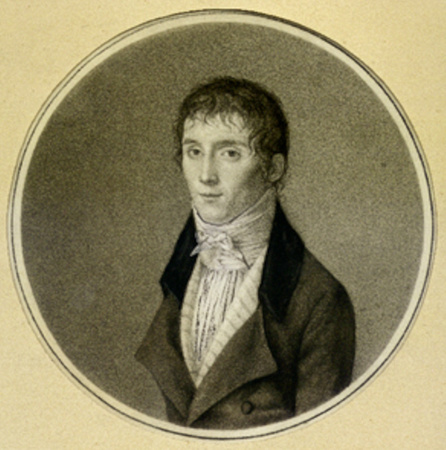Born in 1765 in Chalon-sur-Saône, France, Joseph Nicéphore Niépce enjoyed a comfortable middle-class upbringing. After pursuing early careers in teaching and the military, he returned to his birthplace in 1801 to settle on and administer his family estate, Le Gras. Joining with his brother, Claude, in several experiments and inventions, he adopted the mantle of a scientifically-minded gentleman.
As early as 1793 the brothers had discussed the possibility of utilizing light-sensitive compounds to reproduce imagery. Joseph's earliest experiments in this direction appear to have begun in 1816, but it was not until 1824 that he had some degree of success with permanent photographs from nature. This slow progress is accounted for by the fact that photography was not his sole, or even his main, interest; the invention on which the brothers expended most of their efforts, genius, and ultimately their entire family fortune, was a combustion engine called the "Pyreolophore" for propelling boats. Patented in 1807, this ingenious and surprisingly early combustion engine did actually propel a model boat on the rivers Saône and Seine. The next twenty years were spent in improving and endeavoring to exploit the engine, the latter involving Claude's eventual move to England.
When the craze for the newly invented art of lithography swept France in 1813, it naturally attracted Joseph's attention. Unable to draw well, he placed engravings, made transparent, on stones coated with light-sensitive varnish of his own composition. Thus lithography led to what Niépce later termed Heliography, and subsequently to the first permanent photography from nature, produced on pewter around 1826.
In September 1827, Joseph traveled to Kew near London to visit his brother Claude, who lay dangerously ill. While there, he was introduced to the noted botanist, Francis Bauer, FRS, who examined the specimens Niépce had brought with him and immediately recognized the importance of his discovery. Bauer advised Joseph to write a memoir and provided him with introductions to present the paper and show the specimens to the Royal Society on December 8th. These specimens—which were all referred to by Niépce as "Les premiers resultats obtenus spontanement par l'action de la lumiere"—were returned to him together with the memoir, for the Royal Society felt unable to take cognizance of an invention for which the inventor was unwilling to disclose the details.
Joseph left England shortly afterwards. Before his departure he presented his handwritten memoir and his heliograph specimens (including the First Photograph) to Francis Bauer. The botanist dutifully inscribed the gifts, labeled them 1827 (the year of their presentation to him), and set them aside. Within two weeks of his return to France, Joseph would learn of his brother Claude's death.
Upon his return Joseph continued his experiments. Courted by Louis-Jacques-Mandé Daguerre, the painter, dioramist and entrepreneur, Niépce eventually formed a ten-year partnership with him in 1829. He continued to experiment with heliography, dreaming of eventual recognition and economic success, until his death in 1833. In 1839 Daguerre focused the world's attention upon his own invention, the daguerreotype, and the pioneering work of Joseph Nicéphore Niépce was largely overwhelmed and easily ignored. It would take the combination of Niépce's kind gift to Bauer, the care which Bauer gave to the precious artifacts, and Helmut Gernsheim's persistence and insight, to restore Joseph Nicéphore Niépce to his rightful position as the world's first successful photographer.


